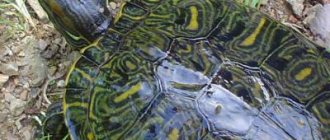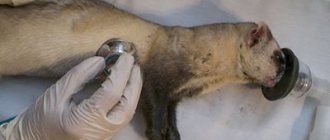What kind of reptile is this?
The red-eared turtle (also known as the yellow-bellied turtle) belongs to the family of American freshwater turtles. Natural habitat is small, often swampy bodies of water with weak currents. They feed on both plant and animal foods. Distributed throughout North and South America.
The external feature is two symmetrical stripes, red, yellow or orange, located behind the eyes (on both sides of the head). The color of the dorsal part of the shell (carapace) is rich green with black and yellow lines. The lower part (plastron) is painted pale yellow with a dark pattern. The pattern from the shell extends to the skin of the paws and head, so the reptile looks striped.
Species of reptiles
There are many species of turtles found in nature, each of which has its own characteristics and lifespan. But not all of them can be grown at home. The most popular are:
- Land turtle - this species includes more than ten genera. Its habitat is the warm latitudes of many continents. Most often, representatives of this species can be found in the desert or steppe, but you can also see them in the forest. They are represented by large-sized individuals with thick legs and a large shell. A distinctive feature is the fused fingers. They can live in natural conditions for up to 100 years. Most people do not live in households longer than 40 years.
- Central Asian - refers to a type of land. A distinctive feature is the shell, which is divided into several sectors and has a yellow or spotted tint. This species can be found in the desert, foothills and near bodies of water. These are small individuals that live no more than 30 years in captivity. Their lifespan in nature is not precisely determined, but on average it is accepted to take 50 years.
- Marine - most often found in warm waters of seas and oceans. They differ from land animals not only in their legs, which look like flippers, but also in their elongated shell. The animal cannot pull its head and legs inside its shell. Most often, sea turtles can be found in large aquariums and zoos. In nature, they can live up to 80 years. But it is impossible to determine how long sea turtles live at home. They are not grown in houses and apartments, because such large individuals will not fit in any aquarium and their maintenance is associated with certain difficulties.
- Aquatic turtle - refers to small individuals that do not grow more than 30 cm. Most often found in the fresh waters of South Africa, Asia and Japan. At home he feels great. This turtle lives up to 50 years both in captivity and in the natural environment.
- The red-eared or yellow-bellied variety is a freshwater species. Its size rarely reaches 30 cm, males are slightly smaller than females. It got its name because of the red spots on the head in the eye area. Makes sounds similar to hissing or squealing. Found in fresh water lakes and ponds. Able to live up to 50 years.
Not all representatives of these species of reptiles can be kept at home. But still, most of them are found in captivity.
How to determine age and gender?
It is possible to determine the sex of a turtle only after it reaches the age of sexual maturity. But even in adult individuals, the differences between males and females remain very blurred and sex determination is possible only by secondary characteristics. The most notable include:
- Claws on the hind limbs. In males they are long, sometimes curved and thickened.
- Tail. The male is wide at the base, long with a narrow tip.
- Size. Females are noticeably larger.
- Shell shape. In males it is longer and narrower.
- The structure of the abdominal part of the external skeleton. The plastron of females is smooth, while that of males is concave.
Please note: some differences are subtle or may be absent altogether, so conclusions are drawn based on several signs.
To obtain more reliable data, you can use scientific methods - blood tests for hormones, radiography and ultrasound.
Finding out how old a reptile is is an even more difficult task. The easiest way is to clarify this point with the seller. If this is not possible, then the date of birth can only be determined approximately. The error will be several years.
One of the most reliable ways to find out the age is to measure the turtle's shell with a ruler from the front to the back edge, without taking into account the bend. By one year, its length should be three to four centimeters.
In the future, sizes depend on gender:
- 2 years. Females - 9 cm, males - 8 cm;
- 3 years. Females – 14 cm, males – 10 cm;
- 4 years. Females – 17 cm, males – 12 cm.
In addition, you can find out your age:
- Counting the rings on the shell. The first is formed before the turtle reaches twelve months. Every year 2–3 rings are added to the pattern.
- By color. The darker the shell, the older the animal. Young turtles (up to 4 years old) have rich, bright colors, then the shell begins to gradually darken.
Life at home
You should not give turtles citrus fruits and fruits, nuts, tomatoes.
At home, a turtle can live a very long time compared to its natural habitat, which is achieved by balancing risk factors.
Several conditions can affect the lifespan of a reptile:
- correctness of the selected diet;
- conditions of detention;
- detection of diseases and their timely treatment;
- possible injuries to the pet.
Small individuals can live in captivity up to 30 years, larger ones - up to 50. But in a zoo, this period increases significantly. This is due to better conditions in old age.
Causes of premature death
The most common causes of death of pets are:
- Improper conditions of detention. Small aquarium, dirty unfiltered water, untimely cleaning, inappropriate temperature conditions.
- Infections. They can appear from aquarium plants, decorative elements, and live food.
- Poor nutrition and lack of vitamins. In nature, a turtle can compensate for the deficiency of any element on its own; when kept at home, monitoring the diet is the owner’s task.
- Lack of qualified veterinary specialists who can correctly and timely diagnose health problems and prescribe adequate treatment.
Lifespan of turtles
Many people consider turtles to be the record holders for life expectancy. But this opinion is based on rare cases of old-timers belonging to large species. But in fact, the survival rate of the young is very low, and the population is maintained by the large number of eggs in the clutch. In the best case, no more than 60% of them hatch, and in the worst case, no more than 5%. The remaining eggs are eaten by predators. Young animals are also a tasty morsel for most animals, as well as for people.
Very few individuals live to be 30 years old. On average, it is believed that a turtle lives no more than 20 years. And the age of old-timers largely depends on the factor of luck. The reptile cannot get out of its shell - it is fused with it.
The larger the individual, the longer its lifespan:
- small ones live no more than half a century;
- large ones - up to 80 years and longer.
If you raise a turtle at home, its life can be either shortened or significantly increased. The latter becomes possible thanks to comfortable living conditions and the absence of dangers.
With enough control and proper care, a turtle can live a fairly long life.
How to extend life?
The lifespan of a turtle depends only on its owner. When creating favorable conditions, proper care and a balanced diet, it increases. To do this you need:
- Select the aquarium size. Minimum 150 liters per adult reptile. Smaller containers can only keep small turtles up to 2 years old.
- Equip the aquarium not only with water, but also with a small island of land (up to 1/3 of the total volume).
- Maintain a stable temperature and avoid drafts.
- Carry out timely sanitization once a week.
- Select decorative elements carefully. Some types of algae are poisonous to reptiles. In addition, you should not decorate the aquarium with artificial plants and shallow soil - turtles will definitely try to eat them.
- Carefully pick up the turtle and avoid falling, even from a small height. In addition to the fact that they have a smooth, slippery shell that can easily slip out of your hands, some individuals can bite and scratch quite strongly.
- Ensure proper feeding. Turtles cannot eat processed food. It is forbidden to give beef, rabbit, turkey, pork, fruits, and grains. Be sure to include in the diet: animal protein (crustaceans, fish, snails, feed cockroaches), greens (algae, lettuce, dandelions).
- Add mineral supplements to food.
In fact, extending the life of a turtle is quite simple - you need to provide it with comfortable living conditions that are closest to natural ones, monitor its condition and promptly apply the necessary measures.
Other interesting articles
- How long do catfish live in an aquarium at home? The aquarium catfish is not just an unusual fish whose behavior is very interesting to observe, but also...
- How to water a land turtle at home Many people who have become owners of land turtles and have studied all the intricacies and nuances of caring for these animals doubt whether they need...
- How many years do fish live? One of the most important questions that concerns any aquarist is how many years do aquarium fish live? Answer…
Adviсe
- Do not keep reptiles of different species in the same terrarium.
- If the reptile escaped from the aquarium and cannot be found, place a bowl of water and your pet's favorite food indoors. Turtles have good eyesight and will respond quickly to treats and water.
- Remember that the depth of the reservoir should allow the animal to easily stick its head out and keep it on the surface.
- Install two thermometers in the aquarium: one for water, the other for air.
- When taking baths, clean the shell with a soft sponge. Brushes injure the animal.
The longest-living turtles are the elephant turtle named Harietta, who lived 175 years, and the Madagascan radiant turtle, Tui Malila, who lived 192 years. Domestic species do not live that long, but they delight their owners for a long time.
Previous
Inhabitants of the 16 most popular species of pet turtles
Next
Inhabitants of the Mysterious Cherry Shrimp in your aquarium
Mating season
Reproduction in reptiles occurs at different times. It depends on the location and type of animal. But all members of the class have similar traits. For the right to fertilize a female, males enter into battle with each other. Land turtles try to turn over or force their opponent to retreat by striking them with their shells. After the competitor leaves the battlefield, the winning male begins courtship. At the same time, he tries to ensure that the female takes the best position for mating.
To attract a mate, the male strokes her face with his limbs or sings.
Females dig holes in the sand to lay eggs. They also often use crocodile nests or their own burrows. The masonry is securely covered with soil from above, and then compacted with light blows of the shell.
The surface of the eggs is covered with a leathery membrane or shell. There are up to 190 of them in the clutch. The incubation period is 91 days. The female lays several clutches during the mating season.
Turtles are solitary reptiles. They look for a mate only during the mating period.
Mr. Tail Explains: Common Mistakes
All problems with these unpretentious pets arise due to the owners’ ignorance of basic maintenance rules. Most often, turtle owners make the following mistakes:
- They do not provide any terrarium for their placement. The pet is forced to look for a secluded corner in the house on its own. He collects dust under cabinets and sofas, and can get hurt and catch a cold from drafts.
- They forget to install an ultraviolet lamp in the turtle's housing. The absence of this radiation spectrum can cause many diseases in your pet.
- Scales are forcibly removed from the skin and scutes from the shells during molting. This is absolutely forbidden to do so as not to injure your pet. When washing, use only a soft cloth.
- They keep several aggressive males together. This can lead to injury and even death to the turtles.
- Wash terrariums using homemade disinfectants. This can easily poison your pets. To clean their territory, you must have your own equipment and special means.
Record holders for longevity
In nature, this type of reptile really leads among living creatures in terms of life expectancy. At the same time, they are not affected by living conditions at all. When studying their physiological characteristics, scientists discovered an amazing fact. It turns out that these reptiles practically do not age. The body of an individual that has just hatched from an egg and one that is already 200 years old functions in the same way. And what a deceptive appearance - wrinkled skin, inhibited movements and delayed perception.
The large turtle, which lives in the oceans and occasionally comes onto land to breed, lives indefinitely. Scientists have not yet figured out how many years of life nature measured out for them. All of them died only from complex viral diseases; not a single individual who died a natural death has yet been found. These animals can stop the heart and fall into a state of suspended animation, and then easily come out of it again. Currently, geneticists are studying the genome of these reptiles in order to discover which gene triggers the longevity program.
It is also true that many pet turtles live for hundreds of years and can be inherited by their descendants. However, they die early due to human fault under the wheels of a car, in the teeth of a predator, due to improper care or as a result of disease.
Taking care of your health
Compliance with all the rules for the care and maintenance of waterfowl turtles in a home apartment will protect the animal from possible infections and diseases. However, any pet can get sick. Common diseases and treatments are presented in the following table:
| Disease | Symptoms | Treatment |
| Abscess / Otitis | Tumor in the ears, on the limbs | Operation |
| Pneumonia | Does not drown, falls over, does not eat, wheezes, white mucus and bubbles appear from the nose | Deadly. Treated in a hospital or at home with injections |
| Conjunctivitis/swelling/redness of the eyes | Swollen eyes, redness, suppuration under the eyelids, lack of appetite | Local treatment |
| Soft/Twisted Shell (rickets / osteopenia / hypocalcification) | Softening of the shell, its curvature | The curvature process is irreversible; local treatment |
| Helminthiasis | Diarrhea/constipation, presence of helminths in tests | Treatment by a veterinarian |
| Dermatitis/skin fungus | Increased shedding, skin redness, white growths | Treatment by a veterinarian |
What does a land turtle eat?
What does a turtle eat in the wild? The basis of nutrition is plant foods. To maintain the required protein balance, animals eat small insects and snails. Reptiles obtain the necessary moisture from succulent plants, but if there is a source of water, they never miss the opportunity to drink it.
Representatives of box turtles eat poisonous mushrooms. This makes their meat inedible.











